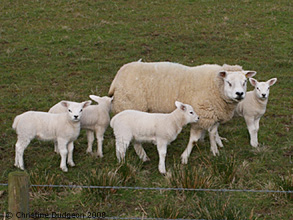Reducing Lamb Mortality
15 February 2017 SRUC researcher Cathy Dwyer shows how basic research into the hormones that regulate the birth process can help guide lambing management.
SRUC researcher Cathy Dwyer shows how basic research into the hormones that regulate the birth process can help guide lambing management.
The ewe has high blood oestrogen levels in late gestation that allows receptors to the hormone oxytocin to operate. Stretching of the birth canal triggers the release of oxytocin which acts as the ‘switch’ to turn on maternal behaviour. The actions of the lamb and the smell of the amniotic fluids surrounding it then direct the ewes attention to the lamb, and lead to licking, low-pitched bleats, acceptance of the lamb at the udder and suckling. The ewe learns to remember her lamb by smell very soon after birth and restricts care to lambs with this smell, later recognising lambs by bleats.
Correct pregnancy nutrition, management and sire selection to avoid difficult deliveries, allowing ewes to lamb in a quiet and stress-free environment away from other ewes if they choose, and ensuring that ewes are exposed to amniotic fluids from the newborn lamb are important. Any management that might interfere with the smell of the lamb can also cause ewes to fail to recognise their own lambs.
First timers are especially vulnerable to disturbance and need particular care to allow a bond to develop with the lamb. First timers need close contact with the lamb within the first half hour after birth or can fail to bond and can get distracted if disturbed, older ewes are more relaxed about this. The better mothering of hill ewes relative to terminal sires is related their higher circulating oestrogens.
Avoiding nutritional and/or psychological stresses, particularly in the last part of gestation helps to maximise maternal care. Management at lambing of heavily stocked ewes should minimise ewe-lamb separation or anything that interferes with the olfactory cues from the lamb.
Outdoor Lambing
Ewes lambing outdoors in open areas usually separate from the flock. Fields with features may help eg rushes, banks etc. minimising visual disturbance. In housed situations, or where several ewes in various stages of the birth process may be in close contact, ewes may swap or steal lambs from other ewes as lambing ewes can be physiologically ready to show maternal care to newly born lambs, and have not yet become selective for their own offspring. They may steal lambs before delivering their own lamb, which may then be rejected, or attempt to mother both their own and the lambs of other ewes, which can increase lamb mortality. Young ewes need to be given adequate time for maternal behaviour to develop and for the transfer of attraction for amniotic fluids to the lamb to occur before attempting to move animals away from the birth site. In practical terms if lambing indoors as a group with individual pens for lambed ewes, the sooner they are penned after lambing the better.
From a selection point including ease of delivery in breeding goals for sheep can improve the expression of maternal care, as well as behavioural development in the neonatal lamb leading to improved survival.
Fostering
Methods that use birth fluids and cervical stimulation, or use of a dead lamb skin, are the most successful in facilitating an immediate acceptance of the foster lamb by the ewe. Methods that transfer the odour of the ewes own lamb to the foster lamb are also successful, compared with restraining the ewe in a lamb adopter. Thus the foster methods based on the biological processes that underpin bonding have the best success.
John Vipond
Sign up to the FAS newsletter
Receive updates on news, events and publications from Scotland’s Farm Advisory Service
